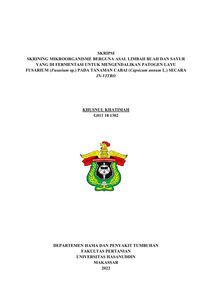Khatimah, Khusnul (2022) Skrining Mikroorganisme Berguna Asal Limbah Buah dan Sayur yang Difermentasi Untuk Mengendalikan Patogen Layu Fusarium (Fusarium sp.) pada Tanaman Cabai (Capsicum annum L.) Secara In-Vitro = Screening of Useful Microorganisms from Fermented Fruit and Vegetable Wastes to Control Fusarium Wilt Pathogen (Fusarium sp.) in Chili Plants (Capsicum annum L.) In-Vitro. Skripsi thesis, Universitas Hasanuddin.
![[thumbnail of Cover]](/24494/1.hassmallThumbnailVersion/G011181302_skripsi_15-08-2022%20cover1.png)

G011181302_skripsi_15-08-2022 cover1.png
Download (169kB) | Preview
G011181302_skripsi_15-08-2022 1-2.pdf
Download (1MB)
G011181302_skripsi_15-08-2022 dp.pdf
Download (2MB)
G011181302_skripsi_15-08-2022.pdf
Restricted to Repository staff only until 19 January 2025.
Download (4MB)
Abstract (Abstrak)
Penelitian ini bertujuan untuk mengetahui jenis-jenis mikroorganisme berguna yang berasal dari limbah buah dan sayur yang difermentasi untuk mengendalikan penyakit layu fusarium pada tanaman cabai. Terdapat sepuluh fermentasi limbah buah dan sayur yang digunakan yang berasal dari berbagai campuran limbah buah dan sayur. Masing-masing fermentasi diencrekan sampai pengenceran 10-6 , kemudian dilakukan identifikasi terhadap mikroba yang telah tumbuh diatas medium PDA dan NA. Hasil skrining mikroba yang diperoleh di uji daya hambatnya terhadap cendawan Fusarium sp. dengan metode dual culture. Mikroba yang memiliki persentase daya hambat tinggi dilakukan uji sinergitas. Hasil skrining mikroorganisme diperoleh 21 mikroba yang diantaranya 5 cendawan dan 17 bakteri. Hasil identifikasi cendawan diperoleh cendawan Trichoderma sp., Aspergillus sp., Gliocladium sp., dan Aspergillus sp. Hasil identifikasi bakteri dengan uji fisiologi yaitu semua bakteri bergelembung di uji katalase, dari 17 bakteri terdapat satu bakteri yang masuk kedalam golongan gram negatif, dan pewarnaan endspora menunjukkan perubahan warna sel dan spora. Hasil penelitian yang diperoleh menunjukkan bahwa terdapat empat cendawan yang memiliki persentase daya hambat tinggi dan bersifat antagonis, terdapat lima bakteri yang bersifat antagonis dengan persentase daya hambat pada hari ke delapan adalah K2M3C1 59%, K2M4C1 56%, K2M6C1 51%, K2M5B1 76%, K2E4B1 66%, K2E2B2 63%, K2M6B2 59% dan K2M3B1 55%. Hasil uji sinergitas menunjukkan mikroba tersebut dapat tumbuh pada medium yang sama.
This study aims to determine the types of useful microorganisms derived from fermented fruit and vegetable waste to control fusarium wilt disease in chili plants. Ten fermented fruit and vegetable wastes were used from various mixtures of fruit and vegetable wastes. Each fermentation was diluted to a dilution of 10-6, then identification of microbes that have grown on PDA and NA medium was carried out. The microbial screening results obtained were tested for their inhibitory power against the fungus Fusarium sp. with the dual culture method. Microbes that have a high percentage of inhibitory power are tested for synergy. The results of microorganism screening obtained 21 microbes including 5 fungi and 17 bacteria. The results of fungal identification obtained Trichoderma sp., Aspergillus sp., Gliocladium sp., and Aspergillus sp. The results of bacterial identification with physiological tests are all bubbly bacteria in the catalase test, of the 17 bacteria there is one bacterium that is included in the gram-negative group, and endospore staining shows changes in cell and spore color. The results obtained showed that four fungi had a high percentage of inhibition and were antagonistic, and five bacteria were antagonistic with a percentage of inhibition on day eight of K2M3C1 59%, K2M4C1 56%, K2M6C1 51%, K2M5B1 76%, K2E4B1 66%, K2E2B2 63%, K2M6B2 59% and K2M3B1 55%. The synergy test results show that these microbes can grow on the same medium.
Keywords : Fermentasi limbah, Fusarium sp., Cendawan, Bakteri, Skrining Waste fermentation, Fusarium sp., Fungi, Bacteria, Screening
| Item Type: | Thesis (Skripsi) |
|---|---|
| Uncontrolled Keywords: | Waste fermentation, Fusarium sp., Fungi, Bacteria, Screening |
| Subjects: | S Agriculture > S Agriculture (General) |
| Divisions (Program Studi): | Fakultas Pertanian > Ilmu Hama dan Peny. Tumbuhan |
| Depositing User: | S.Sos Rasman - |
| Date Deposited: | 03 Feb 2023 01:58 |
| Last Modified: | 03 Feb 2023 01:58 |
| URI: | http://repository.unhas.ac.id:443/id/eprint/24494 |


